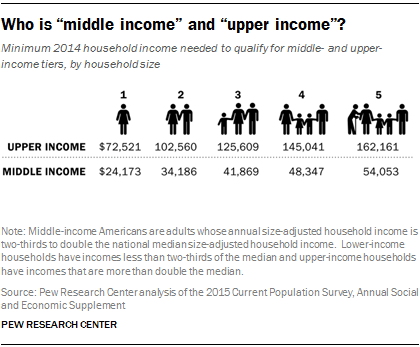
The Middle Class Sure Isn’t What It Used to Be
Daisy Luther
If you’ve noticed that it takes a lot more money to live the middle-class American Dream than it used to, you aren’t alone. Buying a house, saving for retirement, and putting your kids through college while living comfortably is a whole lot harder than it once was. Being part of the middle class sure isn’t what it used to be.
Despite the rosy outlook on employment numbers, things have become incredibly difficult for many families. They’re deeply in debt, living paycheck to paycheck, and without an emergency fund. Let’s take a look at what the media is saying about the middle class.
First of all, what IS “middle class”?
There are many different definitions of middle class, and a lot of it depends on where you live. “Easy,” you may be thinking. “Just live somewhere with a lower cost of living.” Unfortunately, it isn’t that easy, because when you move to an area with a lower cost of living, you’re likely to get paid less for your occupation.
Once upon a time, the middle class was the largest group of Americans. Now, according to the Pew Research Group, it is closely matched by people in the low-income class and the high-income class. The image below shows the stats for 2014.
According to Quentin Fottrell, the personal finance editor for MarketWatch, “middle class” is tough to define:
There is no universal definition of the middle class. The Pew Research Center often uses the middle wealth quintile, the middle 20% of Americans’ income and wealth. Other economists have said it’s defined as making 50% above or below the median annual income. Most Americans regard a college education as a critical component to becoming middle class. Some 71% of people with a college degree consider themselves middle class versus just 58% of people with a high school diploma or less, according to a 2012 survey by Gallup. And yet college graduates in 2017 are shouldering $1.3 trillion in student debt.
Previous studies suggest those who identify as middle class as higher than 50%, but also indicates that the middle class is shrinking. Those who identify as middle class has fallen to 59% in 2010 from 62% in 1991, according to a separate report by the Pew Research Center, a nonprofit think tank in Washington, D.C. (source)
Other sources cite variables like savings, net worth, debt, and spending to determine whether a family is “middle class.”
These two calculators will help you compare your income to others in your area:
For the purposes of this article, we’re going to go with Pew’s definition of the middle wealth quintile.
The middle class is shrinking
The middle class is getting smaller. According to an article on Quartz:
Pew defines middle earners as anyone who earns between two-thirds and twice the median household income in a given year. In 2014, this included a three-person household earning between $42,000 to $126,000 per year. In 1971, 61% of households were middle earners by this standard. By 2015, only 50% were. (source)
The Pew Group said:
After more than four decades of serving as the nation’s economic majority, the American middle class is now matched in number by those in the economic tiers above and below it. In early 2015, 120.8 million adults were in middle-income households, compared with 121.3 million in lower- and upper-income households combined, a demographic shift that could signal a tipping point, according to a new Pew Research Center analysis of government data. (source)
Both of the above articles state that more people are getting pushed into the higher income class than are sliding into the lower income class, which sounds great, initially. But when you look at it more closely, those in the middle class are far less wealthy than they used to be:
…middle-income Americans have fallen further behind financially in the new century. In 2014, the median income of these households was 4% less than in 2000. Moreover, because of the housing market crisis and the Great Recession of 2007-09, their median wealth (assets minus debts) fell by 28% from 2001 to 2013…
…The gaps in income and wealth between middle- and upper-income households widened substantially in the past three to four decades. As noted, one result is that the share of U.S. aggregate household income held by upper-income households climbed sharply, from 29% in 1970 to 49% in 2014. More recently, upper-income families, which had three times as much wealth as middle-income families in 1983, more than doubled the wealth gap; by 2013, they had seven times as much wealth as middle-income families. (source)
It’s getting harder and harder to thrive on a middle-class income
The middle class isn’t what it used to be. Once the “American Dream,”middle-class families are struggling for several reasons. Despite their incomes, they owe more and have saved less than ever before. If you can dig through the politically charged introduction and get to the statistics in this NY Mag article, you’ll find the following:
The percentage of families with more debt than savings is higher now than at any point since 1962, while the median American family’s net worth is lower than it’s been in nearly a quarter-century…
…So, this is what a “good” economy now looks like in the United States: shrinking household wealth; soaring middle-class debt; wage growth that can’t keep pace with the rising costs of housing, healthcare, and higher education; job growth concentrated in part-time positions; widespread retirement insecurity; and more wealth-less households than America has seen for 56 years. (source)
Having more debt than savings is called “negative wealth.” One-fifth of American households fall into this category. Of course, $1 trillion in credit-card debt and $1.4 trillion in student loan debt has to take a toll eventually, right?
Continue Reading
https://www.theorganicprepper.com/the-middle-class-sure-isnt-what-it-used-to-be/

